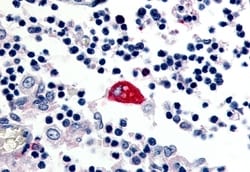Learn More
Invitrogen™ EMR3 Polyclonal Antibody


Rabbit Polyclonal Antibody
Supplier: Invitrogen™ PA532747
Description
Percent identity with other species by BLAST analysis: Human, Gorilla, Monkey (100%); Orangutan, Gibbon (94%); Elephant (89%). For IHC(P), use heat induced antigen retrieval in pH 6.0 citrate buffer. After incubation with the primary antibody, slides were incubated with biotinylated secondary antibody, followed by alkaline phosphatase-streptavidin and chromogen.
EMR3 gene encodes a member of the class B seven-span transmembrane (TM7) receptor family expressed predominantly by cells of the immune system. Family members are characterized by an extended extracellular region with a variable number of N-terminal epidermal growth factor (EGF)-like domains coupled to a TM7 domain via a mucin-like spacer domain. This gene is closely linked to the gene encoding egf-like molecule containing mucin-like hormone receptor 2 on chromosome 19. This protein may play a role in myeloid-myeloid interactions during immune and inflammatory responses.
Specifications
| EMR3 | |
| Polyclonal | |
| Unconjugated | |
| ADGRE3 | |
| ADGRE3; Adhesion G protein-coupled receptor E3; egf-like module containing, mucin-like, hormone receptor-like 3; EGF-like module receptor 3; EGF-like module-containing mucin-like hormone receptor-like 3; egf-like module-containing mucin-like receptor 3; EMR3; UNQ683/PRO1562 | |
| Rabbit | |
| Antigen Affinity Chromatography | |
| RUO | |
| 84658 | |
| Store at 4°C short term. For long term storage, store at -20°C, avoiding freeze/thaw cycles. | |
| Liquid |
| ELISA, Immunohistochemistry (Paraffin), Immunocytochemistry | |
| 1 mg/mL | |
| PBS with 0.1% sodium azide | |
| Q9BY15 | |
| ADGRE3 | |
| Synthetic 18 amino acid peptide from C-terminal cytoplasmic domain of human EMR3. | |
| 50 μg | |
| Primary | |
| Human, Monkey | |
| Antibody | |
| IgG |
Your input is important to us. Please complete this form to provide feedback related to the content on this product.
